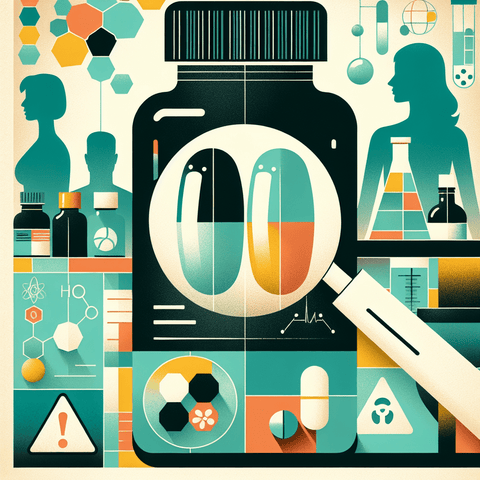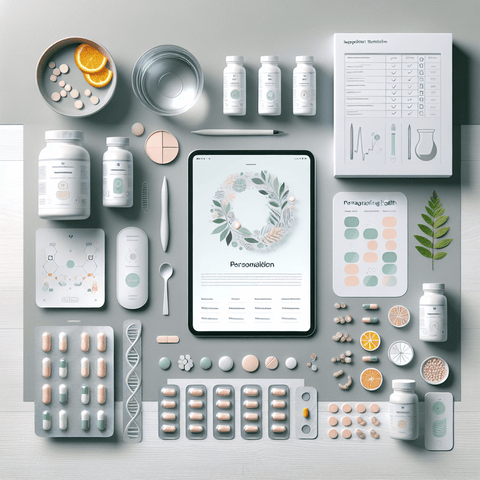Introduction
The global supplement industry has experienced explosive growth in recent years, driven by a growing awareness of health, wellness, and nutrition. Today, you can walk into any health store or pharmacy—or scroll through an online catalog—and find a staggering array of products promising benefits ranging from enhanced immunity to improved brain function. However, with this growth comes a sobering reality: not all supplements are created equal, and some may contain hidden ingredients that can impact your health more negatively than you might think. As consumers become more health-conscious, many of us make the decision to support our wellness goals through vitamins, minerals, amino acids, or herbal blends. However, even the most well-intentioned buyer may fall prey to deceptive labeling practices, unclear ingredient names, and poorly regulated manufacturing standards. The result? Individuals might unwittingly consume low-quality or even harmful substances, masked behind sophisticated marketing. Being able to spot hidden ingredients in your supplements is crucial for maintaining your long-term health. From fillers and binders to undeclared additives, the risks range from allergic responses to toxic buildup in the body. Moreover, some “natural” supplements hide behind proprietary blends, making it harder for users to understand what they’re truly ingesting. This detailed guide will equip you with scientific insights and practical tools to: - Understand what hidden ingredients are and how they can affect your body. - Decode supplement labels with confidence. - Identify harmful fillers and non-disclosed additives. - Differentiate between trustworthy and misleading brands. - Choose clean, transparent supplements that align with your wellness goals. In a world where label transparency isn’t always guaranteed, becoming an informed, vigilant consumer is your best defense. If you take supplements as part of your daily health strategy, it's time to level up your awareness, so you can continue your wellness journey with confidence and safety. Let’s dive deep into the world of supplement labeling and uncover how to secure your health through informed decisions.Hidden Ingredients in Supplements: What You Need to Know
Hidden ingredients are components in dietary supplements that are either not disclosed clearly, masked under vague terms, or presented in ways that make them hard for the average consumer to detect. These can serve various production-related purposes such as improving pill stability, ease of manufacture, or taste and texture. Some common types of hidden ingredients include: - Fillers (e.g., maltodextrin, cornstarch) - Binders and emulsifiers (e.g., stearic acid, microcrystalline cellulose) - Preservatives (e.g., nitrates or sodium benzoate) - Artificial colorings and sweeteners (e.g., FD&C Blue No. 1, sucralose) - Components disguised under "proprietary blends" A proprietary blend is a mix of ingredients listed under a single umbrella term without specifying the exact amount of each component. While legal, this practice prevents consumers from knowing the precise dosage or potency of each ingredient. This is particularly problematic when dealing with stimulants or botanicals, where dosage sensitivity is a critical factor. The inclusion of these hidden elements is often economically driven. Manufacturers use them for: 1. Cost Efficiency: Adding inexpensive fillers increases product volume. 2. Shelf Stability: Preservatives extend product shelf life. 3. Aesthetic Enhancements: Dyes and coatings make pills look appealing. 4. Manufacturing Ease: Binders help powders stick together during production. But what’s the personal risk? 1. Allergic Reactions: Many fillers such as lactose or gluten-containing starches can trigger allergic or intolerance responses. 2. Gut Health Issues: Artificial sweeteners and fibers may negatively affect gut microbiota. 3. Toxicity: Long-term exposure to substances like titanium dioxide has raised red flags in scientific circles, though regulatory stances may differ. Some specific hidden ingredients you should be wary of include: Titanium Dioxide: Used to whiten tablets and capsules. Emerging research raises potential concerns about its accumulation in the body. Magnesium Stearate: Though often used harmlessly as a flow agent, excessive amounts may inhibit nutrient absorption. Artificial Dyes and Sweeteners: Dyes like Red 40 and sweeteners such as aspartame or sucralose are controversial and not universally accepted in health-conscious circles. Being aware of these ingredients improves your ability to select safer, better-formulated supplements. For example, users looking for immunity support may opt for clean-label options such as those found in our Vitamin C supplements collection, which prioritize transparency and quality ingredients.Supplement Label Warnings: Decoding the Fine Print
Reading supplement labels may seem straightforward, but many consumers overlook crucial sections and ambiguous language that can hide problematic ingredients. Start by understanding the structure of a label: 1. **Supplement Facts Panel** – Lists active ingredients and their amounts. 2. **Other Ingredients** – Lists excipients like coloring, flavoring agents, or binders. 3. **Cautions or Disclaimers** – Statements such as “may contain traces of shellfish” or “not evaluated by the FDA.” 4. **Proprietary Blends** – A catch-all list of ingredients without individual component dosages. Some red-flag phrases to watch out for include: - “Proprietary blend” – You don’t know what you're really getting. - “Natural flavors” – A vague term that can include a range of chemical extracts. - “Digestive enzyme complex” – Could include allergens or enzymes lacking clear efficacy. - “May contain...” – Indicates potential cross-contamination, not always acceptable for those with strict dietary restrictions. Also, be cautious of health claims that sound too good to be true. Due to EU regulations (such as EFSA guidelines), most supplements cannot claim to diagnose, treat, cure, or prevent diseases. Always take exaggerated claims with skepticism. What role do certifications play? Look for legitimacy markers such as: - **USP Verified**: Ensures ingredients meet purity and potency standards. - **NSF Certified**: Screening for contaminants and banned substances. - **GMP Certified Facilities**: Signifies Good Manufacturing Practice standards. You can enhance your analysis by researching each ingredient using databases or third-party health websites. Cross-check unknown substances and watch out for pseudo-scientific brand-generated names. At TopVitamine, most of our vitamin assortments—including those in our Vitamin D category—are labeled transparently with attention to ingredient safety and compliance.Undisclosed Supplement Additives: What the Label Doesn’t Tell You
Sometimes the ingredients that pose the greatest risk are the ones not disclosed at all. Due to regulatory gaps and manufacturing complexities, it is possible for supplements to contain additives that are completely left out of labels. Two key factors contribute to this problem: 1. **GRAS (Generally Recognized as Safe) Loophole**: Manufacturers can self-declare substances as safe without FDA involvement. Some additives under this umbrella are chemically complex and not always tested in supplement-specific formulations. 2. **Lack of FDA Pre-Approval for Supplements**: Unlike pharmaceuticals, most dietary supplements are not required to undergo rigorous pre-market evaluation, allowing some products to reach shelves with hidden risks embedded. Common issues include: - Cross-Contamination: Supplements processed in facilities that handle allergens or banned substances may unintentionally contain trace elements not listed. - Inconsistent Sourcing: Poorly sourced herbal or synthetic ingredients may be contaminated with pesticides, heavy metals, or pharmaceutical residues. Independent lab analyses and studies have, on multiple occasions, uncovered shocking findings: - Undeclared pharmaceutical compounds such as anabolic steroids or stimulants. - Trace heavy metals like lead, arsenic, or mercury—particularly in cheap herbals or marine-based products. - Solvent residues leftover from botanical extraction processes. How to protect yourself: 1. Rely on companies that publish independent lab test results for each batch. 2. Use portals like the European Food Safety Authority database or credible science-backed platforms for additive checking. 3. Avoid brands that have been flagged by consumer watchdogs or product recalls. Supplements like omega-3s may be particularly sensitive to these issues due to the marine origin of DHA and EPA. For high-quality fish oil supplements tested for purity, visit our curated DHA & EPA Omega-3 collection.Harmful Supplement Fillers: More Than Just Inactive Ingredients
Fillers are added to dietary supplements to aid in manufacturing processes, improve pill consistency, or reduce production costs. However, not all fillers are benign, especially when consumed over extended periods. Common types include: - Talc: Linked with contamination concerns and banned in some jurisdictions. - Silica: Used as an anti-caking agent. - Starches: Derived from corn, wheat, or rice; can be troublesome for allergenic individuals. - Magnesium Stearate and Stearic Acid: Used for flow enhancement but with controversial data on bioavailability. The potential health consequences? - Allergies: Corn or wheat-derived fillers can trigger reactions in sensitive individuals. - Endocrine Disruption: Certain chemicals used in synthetic coatings and dyes may act as hormone disruptors. - Nutrient Interference: Some excipients may impair the absorption of active ingredients, especially in mineral supplements. There’s a spectrum when it comes to fillers. While some are naturally derived and generally safe, others are synthetic and of questionable benefit. To identify and avoid harmful fillers: 1. Read the “Other Ingredients” section closely. 2. Research unknown names. 3. Choose supplements labeled as “filler-free,” “excipient-free,” or “clean label.” TopVitamine's selection of magnesium-based products in the Magnesium Benefits collection includes several natural, filler-free formulations designed for optimal bioavailability with minimal excipients.Identifying Fake Supplements: Don’t Get Fooled
Counterfeit supplements are another layer of danger, especially for products sold via international third-party marketplaces with limited oversight. Red flags indicating counterfeit supplements include: - Prices that are significantly lower than market value. - Missing batch numbers, manufacturing, or expiration dates. - Packaging inconsistencies (such as spelling mistakes or poor-quality printing). Counterfeit supplements typically enter through: - Online marketplaces not affiliated directly with the brand. - Flash sales or direct-to-door offerings via offshore companies. - Auction-style websites offering high-demand supplements at bargain rates. The risks of counterfeit products include: - Absence of the advertised active ingredients. - Presence of prohibited or dangerous compounds. - Lack of preservation for potency or stability. How to make an informed purchase: 1. Buy only from the brand's official website or verified distributors like TopVitamine. 2. Cross-check product packaging on the official site. 3. Use verification tools or apps to authenticate batch codes, where available. At TopVitamine, every product is sourced directly from licensed manufacturers. For example, our carefully selected Vitamin K collection offers verified, traceable options for consumers who prioritize both safety and ingredient efficacy.Supplement Ingredient Transparency: Choosing the Right Brands
Supplement transparency is an indicator of a brand’s commitment to consumer safety and health ethics. Transparent supplements typically offer: 1. Full disclosure of all active and inactive ingredients. 2. Detailed sourcing including country of origin and extraction method. 3. Certificates of analysis (CoAs) from third parties. Some of the world’s leading supplement verifications include: - NSF International: Ensures no banned or harmful substances. - USP Verified: Indicates compliance with stringent testing for purity and potency. - GMP Certified: Ensures the supplement is manufactured following best practices. Brands that go the extra mile often include QR codes or batch numbers that verify third-party testing results. These should be easy to access, even from your mobile device. What can you look for in a trustworthy brand? - Products with third-party testing seals on the label. - Responsive customer service willing to share testing data. - Positive reviews from health professionals or satisfied customers. Choosing transparent supplements may cost more, but the added assurance about what’s going into your body is worth the premium.Conclusion
Hidden supplement ingredients can undermine even the most well-intentioned health routine. From mislabeled proprietary blends to pharma-grade fillers and undisclosed additives, the risks are real but avoidable. Being a supplement-savvy consumer means you: - Read labels for both active and “other ingredients.” - Avoid vague blends and artificial fillers. - Choose products that adhere to transparency and testing standards. - Purchase through certified, reputable sellers like TopVitamine. Informed buyers protect themselves and their families by choosing supplements that align with proven safety and efficacy standards. Start today by reviewing your supplement cabinet and verifying the trustworthiness of each brand.Checklist for Safer Supplement Choices:
- ✔️ Read every label in full
- ✔️ Investigate any unknown ingredient
- ✔️ Prioritize third-party certified products
- ✔️ Stay educated with reliable sources like TopVitamine
Q&A Section
Q: What are the most common hidden ingredients in supplements?A: These include fillers like cornstarch, binders like magnesium stearate, preservatives such as titanium dioxide, and artificial sweeteners or dyes. Q: How can I know if a supplement is hiding something?
A: Watch for red flags like proprietary blends, vague ingredient names, absence of third-party certifications, or misleading claims. Q: Are proprietary blends dangerous?
A: They can be problematic as they conceal the exact amount of each ingredient, making it impossible to judge potency or interaction risks. Q: Are fillers always bad?
A: Not always. Some natural fillers are gentle and safe. The problem lies with synthetic or allergenic fillers used primarily for cost-cutting. Q: What's the safest way to purchase supplements?
A: Buy from verified, reputable retailers like TopVitamine.com that provide certified, traceable products and transparent labeling.
Important Keywords
- hidden ingredients in supplements
- how to read supplement labels
- harmful supplement fillers
- proprietary blend supplements
- clean-label supplements
- safe supplement brands
- third-party supplement testing
- natural supplement additives
- counterfeit supplements
- transparent supplement labeling



